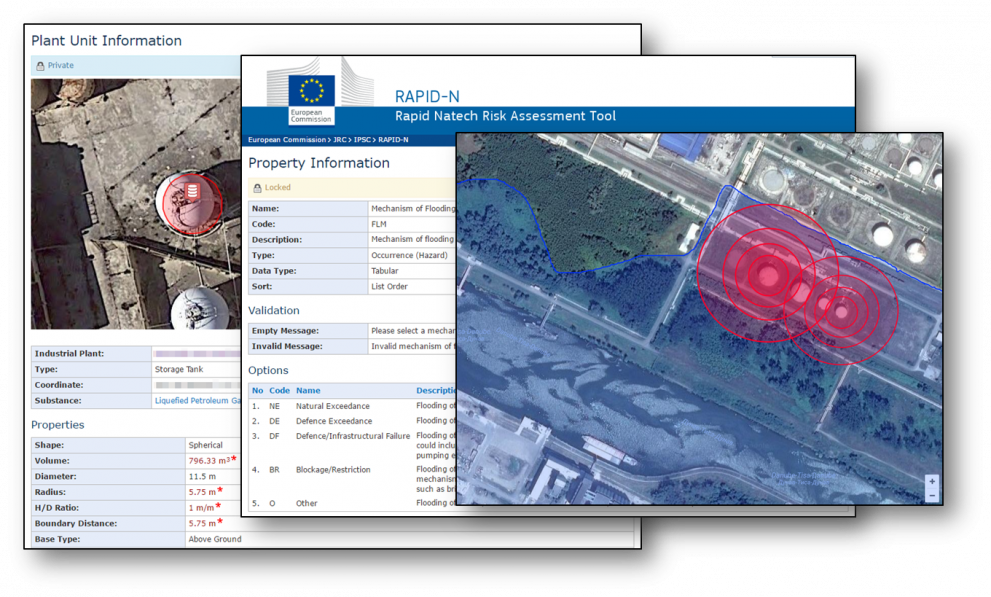Type of support / service available
An online risk assessment tool (called RAPID-N) which aims to support local and regional authorities in the assessment and visualisation of industrial accident risks due to natural hazards (known as "Natech risks").
RAPID-N allows the quick analysis of natural hazard impacts on industrial installations and critical infrastructure that process, store or transport hazardous materials, at local (single asset) or regional (multiple assets) level with a minimum of input data.
The consequences of damage induced by natural hazard impact are modelled and quantitative estimates of consequence severity and likelihood are provided. Technical assistance and training on using RAPID-N and on Natech risk management can also be provided.
Relevance for regional authorities
The impact of natural events, such as earthquakes, floods, storms, etc., on industry and hazardous infrastructure can cause secondary consequences, such as toxic releases, fires and explosions.
These Natech accidents have often had major social, environmental and economic impacts locally, regionally and also globally.
As it is an emerging and multi-hazard risk issue, methodologies for Natech risk assessment are lacking.
RAPID-N closes this gap and helps authorities in the identification and reduction of Natech risks by supporting:
- Identification of Natech risk hotspots where additional protection might be needed;
- Land-use and emergency planning for risk prevention and better preparedness;
- Rapid Natech damage and consequence assessment to inform emergency-response decisions before dispatching rescue teams or to alert the population;
- Screening for potential risks due to cascading effects from a Natech accident.
Policy context
Natech risk is multi-hazard cutting across different disciplines. For this reason, the assessment and mapping of Natech risk supports several EU policies and other legal instruments.
Examples include the Union Civil Protection Mechanism,[1] the European Critical Infrastructure Directive,[2] or the Seveso Directive on the control of major accident hazards.[3]
The assessment of natural-hazard risks to critical energy infrastructure also supports the European Offshore Safety Directive[4] or other relevant legislative instruments related to safeguarding the security of energy supply and infrastructure investment.
Natech risks are expected to increase due to climate change. RAPID-N also supports the EU Strategy on Adaptation to Climate Change[5] by helping to assess the vulnerability of energy infrastructure to climate-change impacts.
In the international arena, the management of technological risks is included in the Sendai Framework for Disaster Risk Reduction, and RAPID-N supports the disaster risk community in assessing Natech risk[6].
How to use
RAPID-N is publicly accessible and only requires an internet connection; it does not involve any installation or third party software.
It is freely available via prior user registration and authorisation and has a user- and mobile-friendly interface with advanced data entry, visualisation and analysis tools.
In order to preserve confidentiality, the system supports data protection and access restrictions for critical information, such as industrial facility data and the associated Natech risk assessment results.
A comprehensive manual including a step-by-step Natech risk assessment tutorial is available from the RAPID-N website.

As the figure above illustrates, the RAPID-N risk assessment output is presented as a summary report including all input data used in the assessment and detailed analysis results, as well as an interactive risk map that displays the severities, probabilities and impact zones of the predicted Natech events.
The current version of RAPID-N supports earthquake and flood Natech risk analysis and mapping for fixed chemical facilities and for onshore pipeline systems.
RAPID-N was designed to support different natural hazards and industrial equipment and JRC provides updates of the system to accommodate user feedback and needs.
JRC regularly offers RAPID-N training for interested users from authorities (local, regional or national) and industry, from within the EU as well as globally.
Training can also be requested and organised on demand. The training curriculum includes familiarising users with the background of the assessment methodology implemented in RAPID-N and hands-on exercises with the system using case-study applications.
Impact
Application of RAPID-N allows authorities to anticipate Natech risks at industry and critical infrastructure in their specific local or regional context.
This supports prevention and preparedness efforts and enhances the safety and security of these technological systems.
This is a prerequisite for sustainable industrial growth and increasing the resilience of the region.
Some EU Member States have requested support with RAPID-N for regional or national emergency response exercises and risk assessment. RAPID-N was successfully used for both purposes, demonstrating its wide range of application areas.
RAPID-N was also used to identify industry vulnerabilities in an earthquake-prone area and to assess the associated potential Natech risks. Based on this assessment, which included recommendations on risk-reduction options, a process of consultation with industry on how to improve safety and supply-security levels was launched.
[1] Decision on a Union Civil Protection Mechanism Text with EEA relevance
[2] Directive on the identification and designation of European critical infrastructures and the assessment of the need to improve their protection
[3] Directive on the control of major-accident hazards involving dangerous substances
[4] Directive on safety of offshore oil and gas operations
[5] Adaptation to climate change
[6] UNISDR - Words into Action guideline: Man-made/technological hazards
